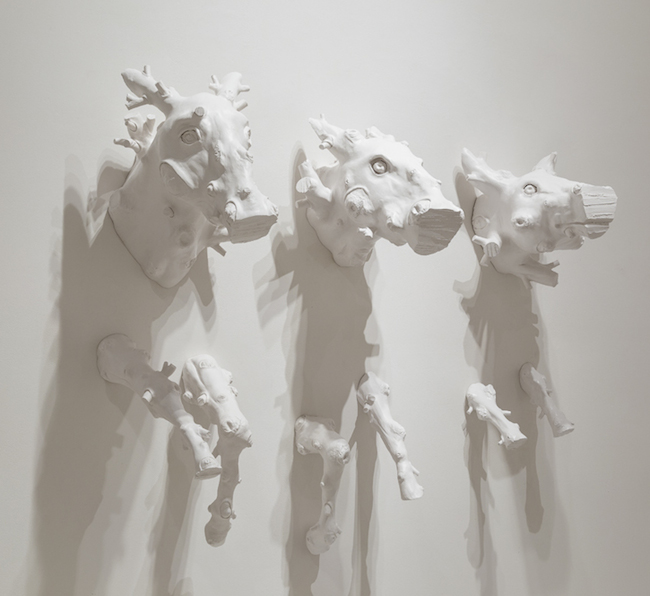San Diego Union Tribune reviewer Robert L. Pincus gave Jeff Irwin high praise when he described his white, porcelain sculpture as “deceitful” but “in a delightful way It evokes one of Picasso’s most famous comments, ‘Art is a lie that tells the truth’.”

Jeff Irwin, Win, Place, Show (two installation views at R.B. Stevenson Gallery), earthenware, glaze, 49 x 65 x 25 inches. Photograph by Philipp Scholz Rittermann. Click to see a larger image.
His review written in 2009 resonates today and gives form and meaning to a gloriously successful and recent exhibition at R.B. Stevenson Gallery (San Diego):
“His current sculptures, true to his established form, look like painted wood branches, knots and all. They are actually made of white earthenware glazed in a subtly luminescent white. He then takes that visual illusion and adds another. The shapes that resemble cut branches coalesce into animals. Sometimes, you get the creature, body and all, as is the case with his rabbit. But much of the time, in this exhibition, you get the head, displayed trophy style on the wall.”


“By shaping the animals to appear as if they are crafted in wood, Irwin establishes visual illusions that sometimes double as visual puzzle. In some you’ll be able to identify the species right away. In others you just might need the title as a clue.”

“Irwin’s pieces work on many levels and before (or after) delving into any of his art’s social commentary, you can simply marvel at the sheer technical and stylistic brilliance, not only in his mimicry of wood, but the ingenuity in conceiving a spectrum of creatures in earthenware. Then, there is the way he uses the properties of wood to underscore the painful truths of the work.”

“These works are a kind of visual essay on our attitudes toward other species. One suspects that, deep down, Irwin is an impassioned moralist who decries our brutal treatment of other creatures. But he takes a restrained approach to his subject. Everything looks pristine, until you start to look closely.”

“The wood knots on ‘Large Antelope’ begin to resemble something else: scars on the animal’s neck. The shortened snout, which perfectly approximates the appearance of a sawed-off chunk of wood, becomes a symbol of mutilation, as do the ears.”

This violence is subtle. Many would miss the point, if they think of wood they do not necessarily consider pain. When you think more broadly— say, the destruction of the rain forest— the carnage produced by diesel-powered chainsaws is grotesque. And as one destroys the habitat for animals one is also, metaphorically speaking, hacking off their noses, trunks, horns, limbs, tails, paws and hooves.

It is at this point, seeing how brilliantly but subtlety Irwin deals with eco-activism, that we feel the full power and— while most would not use this sentiment to describe this exquisitely gentle man— the inner rage.

Installation views at R.B. Stevenson Gallery. Photographs by Philipp Scholz Rittermann.
Irwin’s work will soon be on view in CFile’s hometown of Santa Fe, New Mexico in Trophy: Beast, Prey and Pet at Peters Projects. The exhibition, which opens August 7, is a group show of ceramics and other media (featuring work by Irwin, Adelaide Paul, Beth Stichter, Undine Brod, Michelle Erickson, Alessandro Gallo, John Byrd, Jeremy Brooks and others). It is curated by Mark Del Vecchio and myself. A portion of sales will benefit the CFile Foundation.
Garth Clark is the Chief Editor of CFile.
Any thoughts about this post? Share yours in the comment box below.

Jeff Irwin, Egg Timer, earthenware and glaze, 20 1/2 x 11 x 6 inches

Jeff Irwin, Fragile, earthenware and glaze, 27 x 16 x 14 inches

Jeff Irwin, Bear, earthenware and glaze, 22 x 21 x 20 inches


Brilliant review and really probes Irwin’s work and understands the nuances of his pieces complexity.!
Thanks!!